Symrise researchers went in search of alternatives in 2009. Rather than reinventing the wheel, they explored the company’s database, which has been maintained for many decades and contains some 20,000 molecules. Many had made it onto the market, while research on others had been discontinued due to a lack of opportunity for commercialization at that time.
This also applied to one substance that has now been sold under the brand name Lilybelle® since 2017. Symrise researchers first tested the lily of the valley aromatic substance 35 years ago, but didn’t pursue it – partly because the five-stage synthesis process didn’t make much technical sense on a large scale. Several teams have now completed the product, having optimized the entire process in line with the principles of green chemistry: There are no chemical sensitizers and very little solvent or water, while some reagents are used repeatedly in a catalytic amount.
A strategic decision made by the company played into the researchers’ hands. The raw material basis changed with the acquisition of US company Renessenz, which Symrise had already worked with in the past. Based in Florida, the subsidiary has good access to a strategic raw material, which is transformed into an important intermediate substance: D-limonene is a waste product extracted from the peel during orange juice production. The result is Lilybelle®, a renewable and readily biodegradable fragrance ingredient which is a further proof that Symrise is a leader in innovation.

